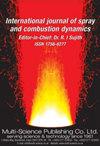Spray response on a model prefilmer under unsteady airflows of various frequencies
IF 2.1
4区 工程技术
Q3 ENGINEERING, MECHANICAL
International Journal of Spray and Combustion Dynamics
Pub Date : 2022-03-01
DOI:10.1177/17568277221092987
引用次数: 1
Abstract
An appealing concept for jet engine combustors is the Lean Premixed Prevaporized (LPP) combustor, which operates at high pressures. The low NOx emissions achieved by lean combustion are one of the targets for modern aircraft engines. However, these types of combustors can introduce thermoacoustic instabilities that can potentially damage the engine and reduce its lifespan. Since the potential instabilities on the fuel spray characteristics, i.e. the spray mass flux, can affect the flame stability, the need arises to investigate the spray response under an unsteady airflow. For this study, a model prefilmer was experimentally investigated to produce a two-dimensional droplet flow without swirl flow. An acoustic forcing in the range of 100–500 Hz was introduced into the airflow, characterized by a hot wire Constant Temperature Anemometry (CTA) setup. Droplet characteristics, namely the droplet diameter distribution and velocity, were determined using a Phase Doppler Anemometry (PDA) setup, while the acquired data were phase-averaged in one period of the airflow oscillation. The influence of the excitation frequency and the air-to-liquid ratio (ALR) on the spray was studied: the spray responded to the acoustic excitation and therefore critical performance parameters, such as the spray mass flux, oscillated indicating potential problems regarding the flame stability.不同频率非定常气流下模型预膜器的喷雾响应
对于喷气发动机燃烧室来说,一个很有吸引力的概念是在高压下工作的精益预混预汽化(LPP)燃烧室。通过稀薄燃烧实现低氮氧化物排放是现代航空发动机的目标之一。然而,这些类型的燃烧器可能会引入热声不稳定性,这可能会损坏发动机并缩短其使用寿命。由于燃油喷射特性的潜在不稳定性,即喷雾质量通量,会影响火焰的稳定性,因此有必要研究非定常气流下的喷雾响应。为此,实验研究了一种模型预膜器,以产生无涡流的二维液滴流动。在气流中引入100-500 Hz范围内的声强迫,采用热丝恒温风速仪(CTA)设置。利用相位多普勒风速仪(PDA)确定了液滴的直径分布和速度特征,并在气流振荡的一个周期内对所获得的数据进行相位平均。研究了激励频率和气液比(ALR)对喷雾的影响:喷雾对声激励有响应,因此喷雾质量通量等关键性能参数出现振荡,这表明火焰稳定性方面存在潜在问题。
本文章由计算机程序翻译,如有差异,请以英文原文为准。
求助全文
约1分钟内获得全文
求助全文
来源期刊

International Journal of Spray and Combustion Dynamics
THERMODYNAMICS-ENGINEERING, MECHANICAL
CiteScore
2.20
自引率
12.50%
发文量
21
审稿时长
>12 weeks
期刊介绍:
International Journal of Spray and Combustion Dynamics is a peer-reviewed open access journal on fundamental and applied research in combustion and spray dynamics. Fundamental topics include advances in understanding unsteady combustion, combustion instability and noise, flame-acoustic interaction and its active and passive control, duct acoustics...
 求助内容:
求助内容: 应助结果提醒方式:
应助结果提醒方式:


